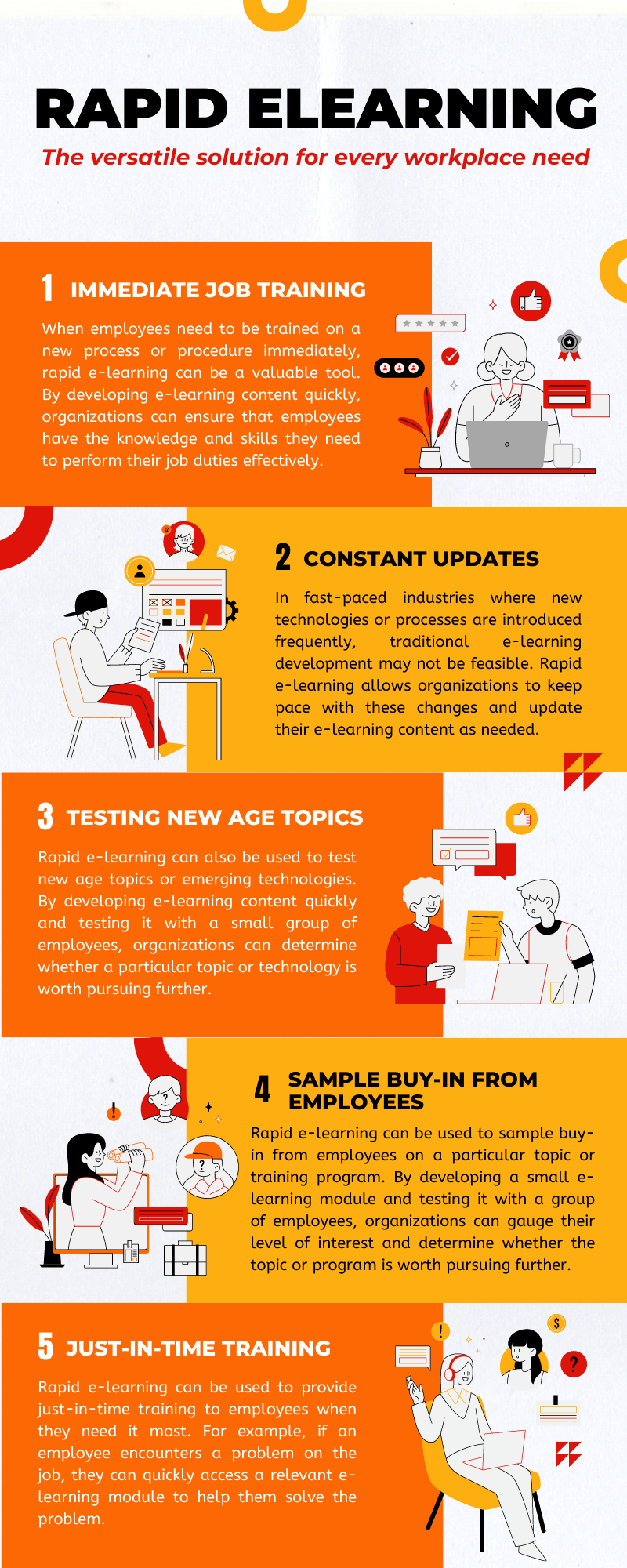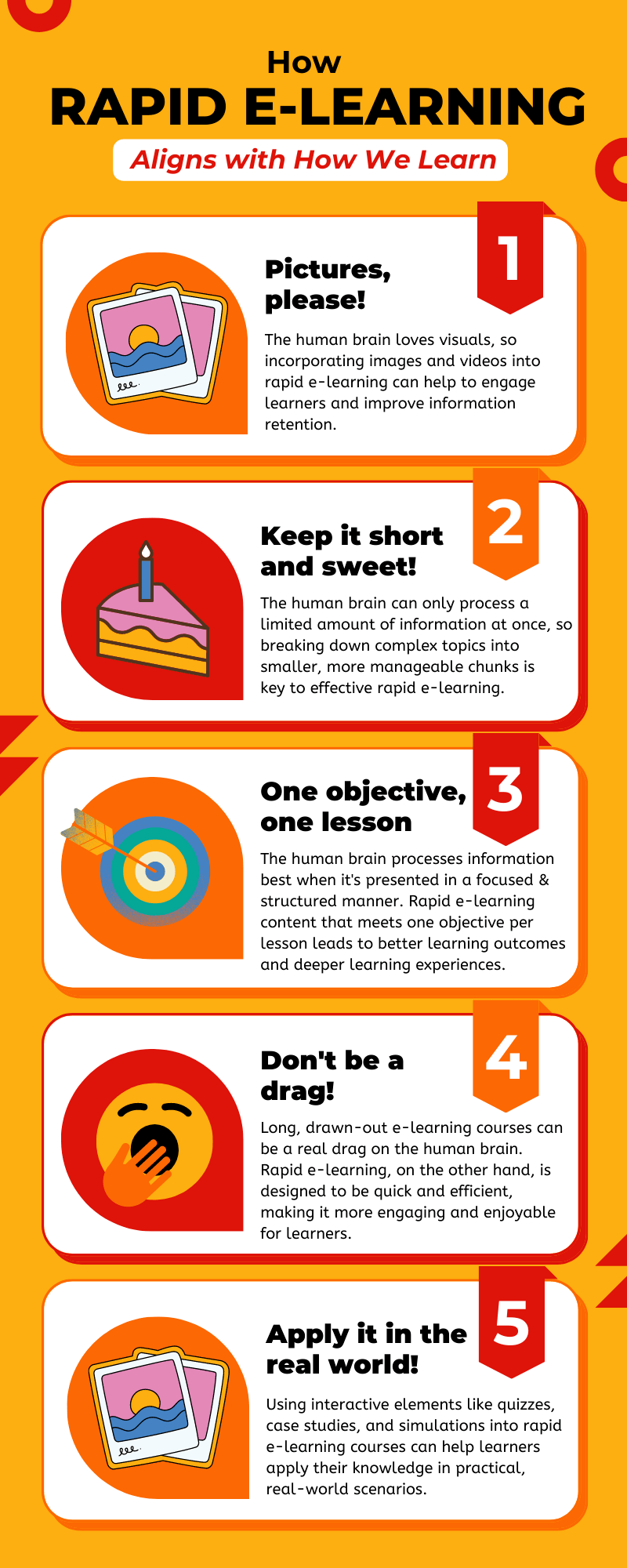Everything You Need To Know About Rapid Learning Content Development
Are you struggling to find the time and resources to develop online training programs and digital assets for your organization? In today’s fast-paced business environment, time is of the essence, and traditional eLearning development may not be feasible. That’s where rapid eLearning services come in. Rapid eLearning is a quick and cost-effective solution for organizations looking to develop eLearning content without compromising on quality. It uses authoring tools requiring minimal programming skills to create interactive and engaging eLearning courses. In this article, we’ll provide you with everything you need to know about rapid eLearning design and development. From the basics of rapid eLearning to best practices and strategies for success, we’ll cover it all. So, if you’re interested in learning how to accelerate your eLearning content development, read on!
What Is The Need For Rapid Learning?
The need for rapid eLearning arises from the fast-paced and dynamic nature of the modern business environment. Rapid eLearning allows organizations to quickly respond to changing business needs, train employees on new skills, and improve overall organizational performance. Moreover, it offers cost-effective solutions to organizations that need to provide training to a large number of employees in a short period.
What Is Rapid eLearning And What Is It Not?
- What it is:
- Rapid development of eLearning content using authoring tools that require minimal programming skills
- Quick development time frames, usually weeks or days, depending on the complexity of the content
- Highly flexible and adaptable, allowing for updates and modifications as needed
- Cost-effective, requiring fewer resources and lower budgets compared to traditional eLearning
- Does not require extensive programming or development skills, making it accessible to a wider range of individuals
- Best suited for narrow, focused topics, such as software simulations, product demos, and process tutorials
- Quality and Instructional Design are given sufficient attention
- Creativity is encouraged and incorporated into the design process
- Efficient project management is still critical to ensure successful development and deployment
- What it is not:
- Lengthy development process using complex programming languages and software
- Development time frames may take months or even years
- Fixed approach to design and development
- Costly, requiring significant resources, including Subject Matter Experts, Instructional Designers, developers, and software licenses
- Requires significant programming or development skills, which may limit who can develop eLearning content
- Best suited for complex, multi-layered topics, such as compliance, leadership, or technical training
- Rapid eLearning does not compromise on quality or Instructional Design
- Rapid eLearning does not mean throwing creativity out of the window
- Rapid eLearning does not do away with efficient project management
When Can Rapid Learning Be Used?
Rapid eLearning can be used in a variety of workplace situations:

Overall, rapid eLearning is a flexible and versatile tool that can be used in a variety of workplace situations. By leveraging rapid eLearning, organizations can quickly and efficiently provide training to their employees, keeping them up-to-date with the latest skills and knowledge needed to perform their job duties effectively.
Instructional Design Models Used In Rapid Learning Content Development
Rapid eLearning typically involves a streamlined Instructional Design approach that focuses on the essentials of effective learning design. This approach is derived from a combination of Instructional Design models, including SAM (Successive Approximation Model), Agile Instructional Design, rapid prototyping, and action mapping. These models prioritize iterative development, rapid prototyping, collaboration, flexibility, and aligning content with the learners’ needs and performance goals. Together, they provide a comprehensive framework for creating effective eLearning content within a shorter time frame. These models work as follows:
- SAM (Successive Approximation Model)
Emphasizes iterative development and rapid prototyping, allowing for quick turnaround time and the ability to respond to feedback and make changes as needed. - Agile Instructional Design
Prioritizes collaboration and flexibility in the design and development process, enabling teams to work together to create effective eLearning content in a shorter time frame. - Rapid Prototyping
Involves creating a rough version of the eLearning content quickly, testing it, and then refining it based on feedback. - Action Mapping
Focuses on aligning eLearning content with the performance goals of the learners and ensuring that the content is practical and relevant.
How Can Rapid Learning Engage The Brain?
By incorporating elements that engage the brain, such as multimedia, interactivity, and practical applications, rapid eLearning can improve information retention, engagement, and motivation.

6 Best Practices For Rapid Learning Content Development
To create effective rapid eLearning content, consider the following best practices:
1. Define Clear Learning Objectives
Before developing any eLearning content, it’s important to define clear learning objectives. This helps to ensure that the content is focused and relevant and that learners understand what they are expected to learn.
2. Use Bloom’s Taxonomy
Align the learning objectives with Bloom’s Taxonomy to ensure that the content covers all cognitive domains, including knowledge, comprehension, application, analysis, synthesis, and evaluation.
3. Keep It Simple
Rapid eLearning content should be designed with simplicity in mind. Avoid complex interactions or animations that can add unnecessary development time and may not contribute to the learning objectives. Use simple graphics, animations, and videos to convey information in an engaging way.
4. Use A Standardized Development Process
To ensure consistency and efficiency in your rapid eLearning development process, use a standardized development process. This can include templates, checklists, and guidelines for development, review, and approval.
5. Incorporate Interactivity
Incorporate interactive elements in your rapid eLearning content to engage learners and promote retention. This can include quizzes, scenarios, simulations, and games that encourage learners to apply their knowledge.
6. Test And Iterate
Finally, it’s important to test and iterate your rapid eLearning content to ensure its effectiveness. Conduct user testing and gather feedback to identify areas for improvement, and then make the necessary changes to improve the content.
Conclusion
Rapid eLearning is a cost-effective and efficient way to create eLearning content that meets the training needs of organizations. By following the best practices outlined above, organizations can create effective and engaging eLearning content that delivers results. Rapid learning services are widely available, making it easy for organizations to implement this approach to training and development.
Image Credits:
- The infographics within the body of the article have been created/supplied by the author.

Thinkdom
Dealing with various outsourcing vendors can be a hassle and drain resources. Thinkdom Learning Solutions streamlines the process by providing engaging and cost-effective solutions for all your online training needs in one place.



















